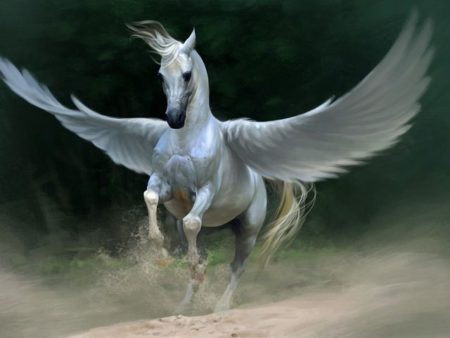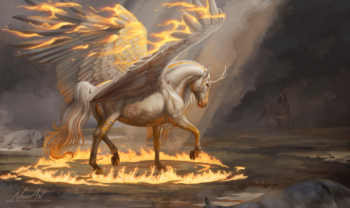
Pegasus – The Facts & Fantasy
(Greek: Πήγασος, Pḗgasos; Latin: Pegasus, Pegasos)
This beautiful mythical creature is classically depicted as a pure white stallion with wings. One of the many children of Poseidon, the famous sea god of Mount Olympus, he was foaled by springing forth from the neck of the severed head of Medusa when the hero Perseus decapitated her by using a reflective shield and winged sandals. That’s right, the Gorgon Medusa was his mom and since she died as he was being born, the movie Clash of the Titans is off about the early pairing of Perseus and Pegasus, but hey the movie was still cool!
Pegasus wasn’t the only one born of Medusa and Poseidon. His brother Chrysaor was born at the same time. Often depicted as a man, not much is known of Chrysaor other than his name meaning “he who bears a golden sword” and that he was a very courageous warrior.
Wild and free Pegasus was only controlled with a golden bridle given to Bellerophon by Athen.
In more modern portrayals you may see great herds of pegasi in a variety of colors over the pure white along with added details like horns and unique tails.
Pegasus Symbolism
Pegasus, the winged horse of Greek mythology, carries a rich tapestry of symbolism. Here are some key examples:
1. Inspiration and Creativity:
- Spring of Hippocrene: When Pegasus struck the ground with his hoof, it created Hippocrene, a magical spring on Mount Helicon, the home of the Muses. Drinking from this spring was said to grant artistic inspiration to poets, writers, and musicians.
- Symbol of the Muses: Pegasus is often depicted alongside the Muses, further solidifying his connection to creativity and imagination.
2. Heroism and Victory:
- Bellerophon: This hero tamed Pegasus with the help of Athena and rode him to defeat the monstrous Chimera. Pegasus’ strength and speed aided Bellerophon’s victory.
- Military Emblem: Throughout history, Pegasus has been used as a symbol of military prowess and victory, representing courage and strength in battle.
3. Transcendence and Freedom:
- Wings: Pegasus’ wings symbolize the ability to rise above limitations and soar into the heavens. He represents the freedom to explore new ideas and break free from the ordinary.
- Birth from Medusa: Emerging from the slain Gorgon, a creature associated with the underworld, Pegasus embodies the idea of transcending the physical world and reaching new heights.
4. Nobility and Purity:
- White Stallion: Pegasus is typically depicted as a white horse, a color often associated with purity, nobility, and virtue.
- Divine Connection: Chosen to carry Zeus’ thunderbolts, Pegasus is linked to the divine realm, symbolizing a higher power or purpose.
These are just some of the many layers of meaning associated with Pegasus. His enduring popularity reflects the human desire for inspiration, heroism, and the ability to transcend limitations.

Pegasus Powers
In myths and legends, pegasus possesses a variety of powers beyond just flight. Here are some of the most prominent:
- Flight: This is the most well-known power of a pegasus. Their powerful wings allow them to soar through the skies with incredible speed and grace.
- Supernatural Speed: Even on land, pegasi are said to be incredibly fast runners, surpassing even the swiftest horses.
- Creation: Some myths depict a pegasus’s hoof striking the ground, causing a spring of water to erupt. This spring might possess magical properties, like Hippocrene, which was said to grant the drinker inspiration for the arts.
- Symbolic Power: Pegasus is associated with the Muses, the Greek goddesses of the arts. This connection imbues them with a symbolic power to inspire creativity and artistic expression.
- Intelligence and Loyalty: While not always depicted this way, some stories portray pegasi as intelligent creatures capable of forming strong bonds with humans.
It’s important to note that the specific powers of a pegasus can vary depending on the myth or legend. However, these are some of the most common abilities attributed to these majestic winged horses.





